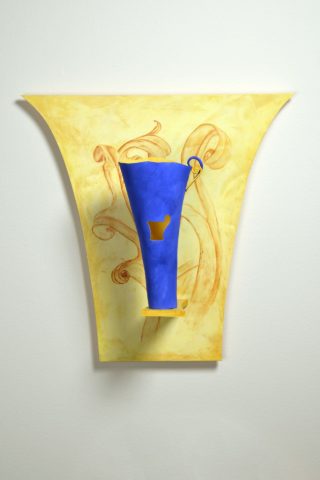The Most Beautiful Dress in the World
La Betty had discovered the Schiaparelli 2016 Spring/Summer haute couture collection while browsing the Internet for a new teapot. La Betty had wanted an antique porcelain teapot. La Betty would not be researching the history of teapots, certainly not the history of porcelain. La Betty assumed it was enough to know her own criteria for a pleasing teapot: first of all it must be a few centuries old; secondly, it must be decorated with lots of gold, and third, as if not associated anyway with the first two criteria, an exhilarating price. Once these criteria were fulfilled La Betty knew what she liked.
The Schiaparelli 2016 Spring/Summer high fashion collection had been extensively documented. That season each ethereal gown was decorated here and there with embroidered depictions of ordinary objects such as scissors, an asparagus bunch, a watering can, a 1963 Western Electric touchtone telephone.
And then a remarkable coincidence occurred. La Betty was admiring a long dilute lavender gown, and there, embroidered on the right breast of the bodice, was a flamboyantly ornate teapot. La Betty downloaded the catwalk photo and began enlarging it. Seeing this teapot in detail La Betty was intrigued how it looked so very French, Monsieur de Clignancourt porcelain actually. It gave a serious impression. It was stodgy yet stately, with a heavy gold handle and a muscular gold spout.
More unmistakably French were the alternating mauve and gold vertical stripes ascending from a wide gold band around the base. The stripes alluded to military parades and riches beyond compare. Beneath the lid was a frieze with finely speckled gold background. Bloated white daisies, calla lilies full of spiders and blood red rosebuds dominated the foreground, along with obviously imaginary plants. The latter gold and mauve plants looked like a fusion of feather with viper tongue. There were also delicate sprigs that looked like desiccated gecko feet. Painted on the lid’s gold knob was a single white blossom of sandbog death lily.
Within moments the calla lilies performed an illusion. They remodeled into bizarre teapots. These sheer white pots had a very delicate small diameter at the bottom. As a whole each one resembled the poisonous yellow oleander. The open mouth at the top of this unorthodox teapot accommodated hundreds of black spiders and their webs. There were two exquisitely serpentine handles.
La Betty immediately cringed at the idea of teapots. She would never have thought that they involved spiders, near-vipers, poisonous flowers or reptile toes. She didn’t drink tea anyway. She had merely toyed with the idea of porcelain and elegance, even perhaps the idea of porcelain and extravagance, but, en fin, this needlework teapot reminded her that sometimes well-wrought things can be unnerving.
La Betty quickly returned her focus to the other Schiaparelli catwalk photos. In a moment she beheld the most beautiful dress in the world. The little white silk bodice was trimmed with close knit gold seashell shapes that encircled the waist, decorated the vertical seam between front and back, and conglomerated at the narrow shoulder straps. On the front of the bodice the circumference of a very big circle was delineated by a dense strand of gold calico clamshells, gold keyhole limpets, gold periwinkles and more. Closed within the circle was an applique image of a stunning though unnaturally scarlet King’s Crown Conch.
From the waist the gown descended floor-length in multilayered shallow blue silk tulle. The blue strata would float and sway with each footstep. Within the layers numerous delicately stitched sea creatures appeared and disappeared, tiny pink crabs, charming silver seahorses, little green ribbontails, dwarf purple sea stars and an assembly of sea weeds such as sea petal, sea whistle, rippleweed and rosy fanweed.
La Betty savoured the gown until the scene changed to an interview of the very model who had worn the gown that year. The interviewer was inquiring about the life of the model, whose only name was Litu. Litu had retired the day after she wore the King’s Crown Conch dress. “Why?” the interviewer had asked. La Betty believed Litu’s answer to be massively deceitful.
“The King’s Crown Conch dress was the most beautiful dress in the world,” answered Litu. “All my life I had wanted to wear the most beautiful dress in the world. I had modeled hundreds of dresses. But that day, in that Schiaparelli gown, the obsession was finished. After wearing the most beautiful dress in the world I was free to be ordinary.”
JEANNIE MAH
Canadian, born 1952
Synthèse #9, from the series "ouvrez les guillemets…", 1997
porcelain, underglazes, acrylic, gouache, gesso, medium density fibreboard
61 x 61.8 x 26.5 cm
Collection of the MacKenzie Art Gallery, purchased with the financial support of the Canada Council for the Arts Acquisition Assistance Program.
1997-13
